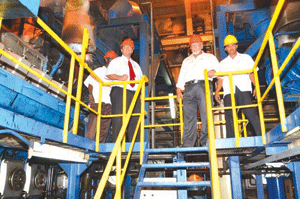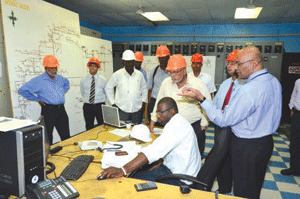– during tour of GPL generating plants
OFFICIALS of the Guyana Power and Light (GPL) yesterday escorted President Donald Ramotar on a tour of three of the generating stations critical to the delivery of electricity on a daily basis to the Demerara grid.  Visits were made to the Garden of Eden, East Bank Demerara, the Kingston Wartsila power plants and the Sophia Sub Station, with Chief Executive Officer, Bharrat Dindyal, GPL’s Chairman, Winston Brassington and board members, among others, elaborating on their functions.
Visits were made to the Garden of Eden, East Bank Demerara, the Kingston Wartsila power plants and the Sophia Sub Station, with Chief Executive Officer, Bharrat Dindyal, GPL’s Chairman, Winston Brassington and board members, among others, elaborating on their functions.
Yesterday’s undertaking was one which President Ramotar had scheduled as he sought to have a greater understanding of the many challenges the power company has been facing, even as it seeks to build generation capacity in a growing economy.
The demand is even greater with the plan to construct the Amaila Falls Hydro Power (AFHP) project which, the experts say, will require approximately 20 megawatts of power from GPL, ahead of the hydro project coming on stream.
President Ramotar later told staff of the power company gathered at the Sophia substation that GPL is an important unit in Guyana’s development and in the fast-tracking of the country’s economic development.
“We cannot have rapid economic development without having energy… that is at the heart of our whole economy, and this industry, from that point of view, is therefore important to us, because it is the basic type of industry that we cannot do without,” President Ramotar said.
The vision of the People’s Progressive Party / Civic (PPP/C) to acquire cheap energy could not be ignored, even as the Head of State spoke of the fervent efforts by the power company and the government, over the years, to invest in generation capacity and loss reduction.
Reference was made to neighbouring countries like Suriname, Venezuela and Trinidad and Tobago that are thriving off of cheap energy, as good enough reason for Guyana to pursue a similar path, while at the same time developing its  fledgling oil and gas sector.
fledgling oil and gas sector.
The benefits of cheap energy to value-added in the productive and manufacturing sectors were also highlighted by the President, with his only disappointment being the criticisms that the government has been facing since announcing its intentions to invest in hydropower; and, according to President Ramotar, the naysayers are ignorant of the overarching goal of the initiative.
The hullabaloo had led to a detailed explanation session on the details of the project by Brassington to members of the Opposition at the invitation of President Ramotar, in an attempt to clear the air on some of the ambiguities.
President Ramotar believed that for too long the Opposition has been playing “cheap politics” on the issue, in a malicious attempt to “damage something that is good.”
The government is, however, looking further in the direction of cheap energy and along a renewable path.
President Ramotar told the workers that given the rapid growth in the economy, and the prediction by experts that the AFHP will be exhausted after a period, the government is also looking to develop other sources.
Co-generation from Skeldon and the cultivation of lands for the production of ethanol are just some of the projects in the making for the promotion of renewable energy.
At the Garden of Eden station, President Ramotar got a firsthand look at how the power generating capacity has evolved over the years, when he saw some of the generators that were used in the past, but are now obsolete.
Dindyal told the Head of State about the extraordinary cost that had been incurred by the company to repair the equipment, the transition to Heavy Fuel Oil (HFO), and plans in the making to rehabilitate the fuel storage area.
At the Kingston power plant, the President was given an illustration of the plant’s computerised operations while in the control room, where the engineers are able to closely monitor the entire operations.
The 20.7MW Kingston plant, consisting of 6.9MW Wartsila turbines, is one component of an integrated transmission project under a partnership agreement between the governments of Guyana and China.
The project includes upgrades in transmission lines from Kingston, Georgetown, to Versailles, West Bank Demerara, via submarine cables, and the construction of seven new substations at Georgetown, D’Urban Backlands, Diamond, Good Hope, Mahaica, Versailles, and Edinburgh, and upgrades to Onverwagt and Sophia.
The construction of a Supervisory Control and Data Acquisition (SCADA) system, which will better enable communications and control of the system from a centralised location, is also included in the project.
Energy is at heart of Guyana’s economy – President
SHARE THIS ARTICLE :
Facebook
Twitter
WhatsApp



.jpg)









